Multimedia environments have changed each of the stages of the writing process—pre-writing, writing, re-writing, and post-writing. Writing is not a linear process but the focal point of many other processes. Writing can be facilitated by an environment that is non-linear and rich in connecting together many different abstractions and occurrences. This is where multimedia will aid this connected but diverse assembly of phenomena. A visual representation of the model using the Snake and Ladder board game depicts this connected and non-linear approach to the writing process in a multimedia environment.
A computer's multimedia environment, an enlargement of the writing process in French, presents new and innovative potentials for learners and teachers. New word processors, or the improvement of existing scripting capacities for writers, are now possible at various stages of the writing process for French students or those learning French as a second language. For example, idea-generators, brainstorming software, databases, electronic libraries, access to the Internet, and CD ROM applications can enhance the way writers have learned to compose texts. Multimedia environments appeal to conceptual learners, visual learners, and auditory learners, as well as to those who learn best by doing things.
Multimedia can and should be used throughout the curricula (Apperley, Cruz & Garza, 1994; Bell & Bell, 1994; Bird, 1994; Miguel, Horneber, Ballenger & Williams, 1994; Simard, 1994) as part of the writing process. This technology will affect the way writers handle the task of writing in French, a hard subject to master. Rules and exceptions abound in spoken and written French. To make matters worse, the act of writing itself is a complex process that involves many sub-processes. A model adapted and enlarged from the model proposed by Plante, Proulx, Simard & Lavoie, 1987 bases itself on a cybernetic and dynamic explanation (Daiute, 1985; Graves, 1983; Smith, 1982) of the writing process, which is facilitated by computers and multimedia environments.
It is hard to consign into only one archetype the complex association of processes that affect writing. Writing is not a linear process but a focal point of many other processes that come together for a specific purpose. Writing can be facilitated by an environment that is non-linear and rich in connecting together many different abstractions and occurrences. Additionally, an awareness of the mechanism that comes into play in the writing process will make learning that assembly of processes easier (Graves, 1983; Smith, 1982). This is where multimedia, and its underlying foundation of hypermedia, will aid this connected yet diverse assembly of phenomena.
The Four Stages of the Writing Process in a Multimedia Environment
In French schools, most writing exercises aim at learning the rules and procedures for writing and seldom focus on writing as a product. Learning the process of writing implies that the person will learn the how to write and will be able to apply and transfer this process to many other situations. Thus, there is an intimate connection between learning the process and writing. Multimedia environments facilitate learning the writing process. Multimedia environments appeal to many types of learners and potential writers: those who prefer to imagine and picture things, those who need to see things, those who like to hear and say things, and those who learn best by doing things. Previous models often depicted the writing process as a linear set of activities that started with the introduction of a topic and ended with a finished product, a text of some sort. The model proposed here implies that writing is not a linear affair and that it goes beyond the finished typed product. After a topic is consigned to paper, many other activities will take place in real life, as opposed to obtaining a grade for the writing activity that took place in a school setting. For example, writing a resume may obtain an employment interview, writing an article may generate reaction from readers, or writing an essay on ecology may change public opinion on the matter. This is also the case with many other real life applications of the writing process.
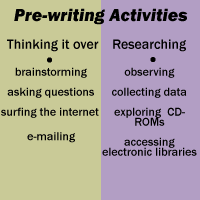 Pre-writing. Pre-writing activities include thinking of a topic and researching
this topic. In multimedia environments the dreaded white page syndrome need not exist
anymore. Idea generation via group brainstorming, questioning via electronic mail,
participating to large listserv groups, observing pictorial representation on the
Internet, reading data collected electronically, exploring CD ROMs and accessing
electronic libraries are examples of multimedia activities that may take place in this
stage of the writing process.
Pre-writing. Pre-writing activities include thinking of a topic and researching
this topic. In multimedia environments the dreaded white page syndrome need not exist
anymore. Idea generation via group brainstorming, questioning via electronic mail,
participating to large listserv groups, observing pictorial representation on the
Internet, reading data collected electronically, exploring CD ROMs and accessing
electronic libraries are examples of multimedia activities that may take place in this
stage of the writing process.
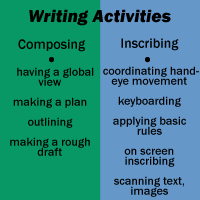 Writing. Writing activities include composing and inscribing. In this stage, a
multimedia environment can facilitate the process. Planning and outlining an essay with
special software, making a rough draft with speech-recognition software, scanning text and
images, entering data directly on screen, as opposed to writing longhand and then
transcribing to the screen, are illustrations of multimedia potential for this stage of
the writing process.
Writing. Writing activities include composing and inscribing. In this stage, a
multimedia environment can facilitate the process. Planning and outlining an essay with
special software, making a rough draft with speech-recognition software, scanning text and
images, entering data directly on screen, as opposed to writing longhand and then
transcribing to the screen, are illustrations of multimedia potential for this stage of
the writing process.
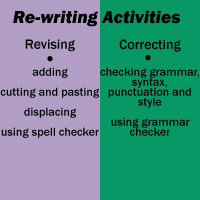 Rewriting. Rewriting activities involve revising and correcting.
Multimedia can affect this stage of the process by allowing add, cut, and paste sequences
using voice recognition as opposed to keyboarding activities, using a spell checker, using
written language recognition software to listen to an essay or an article, and correcting
orthography, grammar and syntax with interactive voice activated software.
Rewriting. Rewriting activities involve revising and correcting.
Multimedia can affect this stage of the process by allowing add, cut, and paste sequences
using voice recognition as opposed to keyboarding activities, using a spell checker, using
written language recognition software to listen to an essay or an article, and correcting
orthography, grammar and syntax with interactive voice activated software.
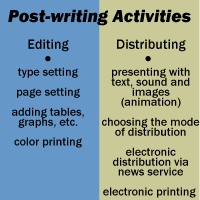 Post-writing. Post-writing activities are consequent dimensions of
the writing process that multimedia has facilitated. Editing and distributing with electronic
facilities adds new meaning to this portion of the writing process. An essay need not be
two-dimensional and linear as it has been in the past. Adding color, animation, images,
audio, and video to a text can change the way information or investigation results are
transmitted and illustrated in a school setting. Already, students are presenting the
result of their work in multidimensional fashion in addition to the traditional written
presentation. Teachers will need to have access to a multimedia environment to properly
evaluate student works. Even the intended mode of distribution will play a role in the
selection of the final set of activities. Distribution via the World Wide Web of student
work will induce and entice more that the written essay. Multimedia class projects will be
open to constant review and reorganization of students intellectual production, a true
picture of real life writing process.
Post-writing. Post-writing activities are consequent dimensions of
the writing process that multimedia has facilitated. Editing and distributing with electronic
facilities adds new meaning to this portion of the writing process. An essay need not be
two-dimensional and linear as it has been in the past. Adding color, animation, images,
audio, and video to a text can change the way information or investigation results are
transmitted and illustrated in a school setting. Already, students are presenting the
result of their work in multidimensional fashion in addition to the traditional written
presentation. Teachers will need to have access to a multimedia environment to properly
evaluate student works. Even the intended mode of distribution will play a role in the
selection of the final set of activities. Distribution via the World Wide Web of student
work will induce and entice more that the written essay. Multimedia class projects will be
open to constant review and reorganization of students intellectual production, a true
picture of real life writing process.
Consequences for the Writing Process
This multimedia-based model implies that writing is more than a sequence of events. Writing is the occasion for many skills and attitudes to come together for a specific purpose. Multimedia allows for loops and branching in any of the four stages described here. We recommend that writing be regarded as an interactive and iterative series of processes that come together not just for the production of written text, but also for real multimedia presentation of intellectual excitement in an increasingly rich environment.
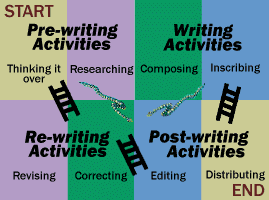
References
Apperley, S., Cruz, P. & Garza, E. (1994). Theme summary: Theme nine - Curriculum design and development. Conference Pproceedings: The Eleventh International Conference on Technology and Education. Deciding Our Future: Technological Imperatives for Education. Austin, TX: The University of Texas at Austin, College of Education.
Bell, J. & Bell, N. (1994). Techtools for effective schools. Conference Proceedings: The Eleventh International Conference on Technology and Education. Deciding our Future: Technological Imperatives for Education. Austin, TX: The University of Texas at Austin, College of Education.
Bird, P. (1994). Multimedia and educational change: Creating a multimedia literate community. Conference Proceedings: The Eleventh International Conference on Technology and Education. Deciding our Future: Technological Imperatives for Education. Austin, TX: The University of Texas at Austin, College of Education.
Daiute, C. (1985). Writing and computers. Addison-Wesley Reading, MA: Publishing Company.
Graves, D.H. (1983). Writing: Teachers and children at work. Exeter, NH: Heinemann Educational Books.
Miguel, T.S., Horneber, M., Ballenger, J. & Williams, C. (1994). Theme summary: Theme three - The changing role of the teacher. Conference Proceedings: The Eleventh International Conference on Technology and Education. Deciding our Future: Technological Imperatives for Education. Austin, TX: The University of Texas at Austin, College of Education.
Plante, J-L., Proulx, L., Simard, G. & Lavoie, B. (1987). L'ordinateur, le traitement de texte et les bases de donn?ɬ©es comme outils d'apprentissage. Sainte-Foy, QC: Les ?É‚Ä?ditions du 24 juillet Inc.
Simard, J.P.J. (1994). Computer-based solutions for automotive marketing francophone students to succeed at the Canadian Automotive Institute, Georgian College. Conference Proceedings: The Eleventh International Conference on Technology and Education. Deciding our Future: Technological Imperatives for Education. Austin, TX: The University of Texas at Austin, College of Education.
Smith, F. (1982). Writing and the writer. New York: Holt, Rinehart and Winston.
word gamesplatform gamesbrick busterkids gamesdownloadable pc gamescard gamesmanagement games

